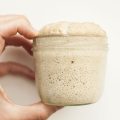Proofing your dough is an important process in all bread baking. Skipping this step will result in failed loaves, so here’s what you need to know about proofing baskets and proofing basket alternative ideas!

What Is Proofing?
Proofing is the process of setting the dough aside to rise and rest. It is also an essential step in bread baking. This is the final rise of the dough before it is placed into the oven.
While the dough rests and rises, the yeasts in the dough begin to ferment, and produce gases that cause the bread dough to rise. These gases create the wonderful air pockets when baking bread.
What is a Proofing Basket?
A sourdough proofing basket or banneton is a round basket made to proof dough.
While the dough rests in the proofing basket for hours, the basket supports the dough and prevents it from spreading and spilling over the edges while expanding.
How to Use a Proofing Basket
Before you place your shaped dough into the proofing basket, you should dust the top of the loaf, followed by the sides of the basket with rice flour to prevent sticking.
Do not use wheat flour as this will cause your dough to stick to the proofing basket.
Best Proofing Basket Alternatives
If you’re not an avid baker, you’re probably looking for a proofing basket substitute. And while there are affordable proofing baskets out there, spending money isn’t always at the top of the list!
Here are some efficient proofing basket alternatives for bread proofing:
- Bowl
- Colander
- Heavy cloth
- Plastic container
- Wicker basket
- Baking tray
- Wok
Bowl
If you don’t have a proofing basket for your sourdough bread, then you must have a bowl big enough for proofing sourdough.
A bowl will give your loaf a nice rounded shape, and while you may want to create different shaped loaves, it is better than nothing!
Both plastic and ceramic bowls will do the trick, although wooden and bamboo bowls would work as well. Avoid using metal bowls, as the coldness of the bowl can jeopardize the fermentation process. Though if you must, then line the metal bowl with clean fabric and place the dough inside.

Colander
The best feature about this proofing basket alternative are the little holes.
The holes in the colander promote decent air flow, so that the outer layer of the dough dries out, promising a wonderful crispy crust when baked.
Remember to line your colander with a soft floured cloth, to prevent the dough from sticking.
Heavy Cloth
If you’re sick of round loaves and want to bake a sourdough baguette instead, you can use a heavy proofing cloth to proof your bread.
Sprinkle a generous dusting of flour, before placing your dough onto the heavy fabric. Create folds or pleats and hold them in place with a peg.
Plastic Container
If you’re after that beautiful oval shaped loaf, then plastic containers might not be the best option for proofing dough.
Normally, plastic containers are rectangular, so this may cause your loaf to emerge a little shapeless.
However, it’s no secret that containers do come in all shapes and sizes.
So if you happen to own a rounded container, that is neither too big or too small for the dough, add a dribble of oil to prevent sticking or a floured towel to line the container.
Wicker Basket
Wicker baskets are another great proofing basket alterative. They’re especially amazing at adding a unique and wonderful pattern to your loaves.
Simply clean out your old wicker basket, ensuring that it is safe, then lower your sourdough into the basket.
Baking Tray
If your bowls are busy doing other jobs, you can use a baking tray to proof the dough. Just remember to use a baking tray with high sides, so that the dough doesn’t rise and spill over the edges.
Layer your tray with some kitchen towels to create a makeshift bed for your dough to rest on. Cover the tray with a tea towel, dust some flour on it, then add your dough.
Wok
A wok is probably the most unexpected proofing basket alternative to make the list. But it’s domed bottom is what makes it so special. This will cradle your dough, and support it while it rises.
Line the wok with a heavy linen cloth before lowering the dough into it.

Some Proofing Tips
If you are relatively new to the baking world, here are some tips to help you with proofing bread dough, to bake a wonderful soft and airy bread.
Avoid overproofing, or underproofing your dough!
Prep Proofing Basket
When using a proofing basket for the first time, it’s important to prepare them to prevent the dough from sticking to its surface.
Spray your proofing basket with water, then add a cup of flour to it and spread it all over the basket, shaking off the excess.
Make sure to not use too much flour as this will ruin the appearance, texture and taste of the bread.
Spray Water on the Towel
If your towel has become stuck to the dough, spray it with a little water. Try to gently pry the towel off the dough without damaging the bread dough.
Avoid Mold
If you forget to wait for your proofing basket to dry after spraying with water and dusting with flour, the basket will become moldy.
Once you notice that your proofing basket has mold on it, place it into a 250 degree F oven for 30 minutes. The hot oven will kill the mold, enabling you to use the basket once again.

Perfect Proofing
For beautifully risen sourdough loaves, always use a proofing basket.
If you don’t own a fancy bakers proofing basket, anything that can hold the shape of your dough will do the trick.
Ensure that your dough doesn’t stick to the proofing basket substitute, or you will experience some problems!
Proofing Basket Alternative Options – FAQs
Are Proofing Baskets Necessary?
Although proofing baskets aren’t a necessity, when it comes to proofing bread dough, you’ll need a bowl, or cloth to help shape your dough, before you bake bread.
Can I Make My Own Proofing Basket?
You can make your own makeshift proofing basket using anything you like, as long as it’s strong enough to hold the shape of your dough.
Can I Use Any Basket to Proof Bread?
A metal or plastic colander can be used as a proofing basket alternative. The smaller the proofing basket, the better, as this will prevent your dough from spreading out.




![Bulk Fermentation Sourdough, Explained! [Your Easy Guide] 8 Bulk fermentation sourdough explained [easy guide]](https://www.mydailysourdoughbread.com/wp-content/uploads/2023/01/CD-blog-images-2023-01-05T180333.452-120x120.jpg)

